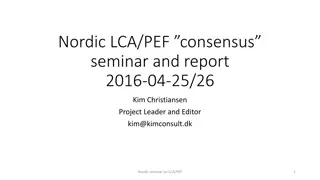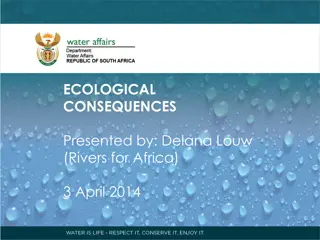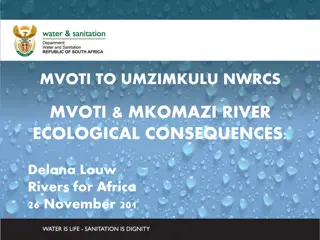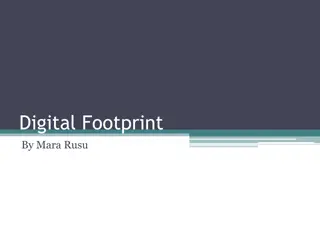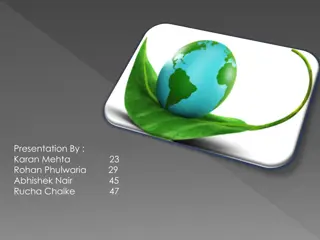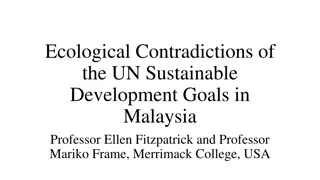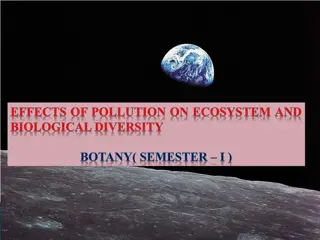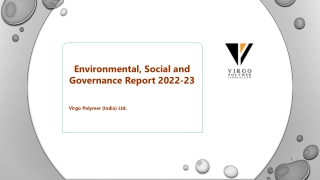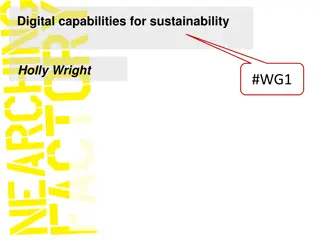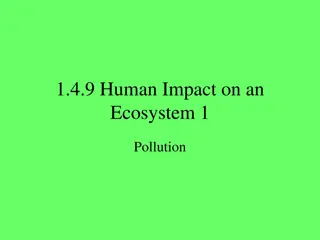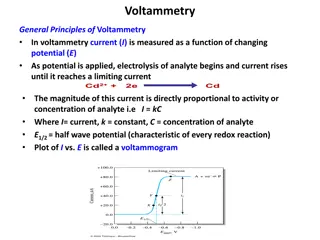Understanding Ecological Footprint: A Vital Sustainability Indicator
The ecological footprint measures the productive land and sea surfaces needed to support a country's resource consumption and waste generation. It informs the surface area required to renew resources used and emphasizes the importance of sustainable practices for a balanced ecosystem.
- Sustainability
- Ecological footprint
- Resource consumption
- Sustainable development
- Environmental awareness
Download Presentation

Please find below an Image/Link to download the presentation.
The content on the website is provided AS IS for your information and personal use only. It may not be sold, licensed, or shared on other websites without obtaining consent from the author. Download presentation by click this link. If you encounter any issues during the download, it is possible that the publisher has removed the file from their server.
E N D
Presentation Transcript
What is the ecological footprint? The ecological footprint is one of the indicators that helps guide the development of sustainable future. states' policies towards a
The ecological footprint: what it measures and how it does it? The Footprint is: The ecologically productive area needed to satisfyourcurrent lifestyle indefinitely The lifestyle that consumes more than what the Earth offers us is not sustainable The ecological footprint measures the productive land and sea surfaces that are needed to generate the resources consumed by a particular country, and those that would be necessary toabsorb the emissionsand waste it produces.
The ecological footprint informs of the productive surface - land and sea - that is necessary to renew the resources used by the population of a particular country, in a given year, with the technologies and management of resources of that moment.
The ecological footprint calculation considers five basic types of resources: food, housing, transport, consumer goods and services. The calculation of this indicator has two main components: ecological supply (bioproductive capacity) and demand on nature (the ecological footprint).
The premises on which the calculation is based are clear. They are summarized in the following six points: 1. The annual amounts of resources consumed and of wasteor air emissions generated by a country are quantified by national and international bodies 2. The amount of biological resources appropriate for human use is directly related to the amount of bioproductive surface required for the regeneration and assimilation of waste.
3. The different areas can be expressed in terms of standardized average production per hectare (global hectares (gha)), based on the usable biomass productivity ratio. 4. Global demand can be aggregated, adding all the areas that, mutually exclusive, provide resources and assimilate wasteoremissions.
5. Aggregate human demand (ecological footprint) and nature's supply (bioproductive capacity) can be directly compared. 6. If the demand area exceeds the supply area, it means that the demand exceeds the regenerative capacity of the existing natural capital, and therefore creates an ecological deficit, which is measurable.
The calculation of the ecological footprint in Catalonia The result of Catalonia's per capita ecological footprint of 2010 is summarized in the following table: Categories PR (hag/h) Spaces for urban settlements and communications 0,03 Space for food production (crops) 0,49 Space for food production (pasture) 0,99 Space for forestry production 0,08 Space associated with energyconsumption and CO2 absorption 1,02 Space associated with the sea 0,65 TOTAL 3,26
This magnitude, multiplied by the nearly 6 million inhabitants at the time, gave an ecological footprint of 19,8 million ha, which is 6,5 times greater than the extension of Catalonia, which is 3.032.840 ha. And since the bioproductivesurface (or carrying capacity) of Catalonia was calculated to be 1 ha per capita, the ecological deficit of Cataloniain 2010was estimated to be -2,2 hag/h
Seven years later, the Advisory Council for Sustainable Development, promoted the calculation of Catalonia's ecological footprint. Categories PE (hag/h) Spaces for urban settlements and communications 0,033 Space for food production 2,03 Space for forestry production 0,043 Space associated with energy consumption 1,60 Space associated with the importation of properties 0,21 TOTAL 3,92
In foreign tourists, that is about 25 million tourists. Given their respective average stays, it was estimated to be about 442,508 permanent residents. Therefore the real population of Cataloniawasestimated to be 6.8 million. 2001 Catalonia tourists received and 4,751,800 20,485,000 Spanish If you divide by this number of inhabitants, the value of the ecological footprint per capita would be 3.67 hag / h, slightly lower than the standard calculation.
The ecological footprint of the population of Catalonia as a whole grew, from 6.5 to 7.7 times its own surface. In other words: during this period, Catalonia experienced a sharp decline towardssustainability
At the European level, the states with the highest ecological deficit in 2005 were Spain (-4.4 hag / h), Greece (-4.2 hag / h) and Belgium (-4 hag / h) ( WWF, 2008). Catalonia's ecological deficit (calculated from 2001 data) was at an average position, but the trend until 2015 was negative.
Proposed strategies that have the most potential to reduce the ecological deficit are: Improve the use of resources by implementing eco-efficient technologies that provide the same services using less resources.
Reduce per capita consumption, especially in foods that have a large ecological footprint, such as meat and other products from intensive farms, or foods imported from distant continents thatare cultivated orcan be grown here.
Increase, where possible, natural productivity per unit of surface in an environmentally friendlyway.
In Catalonia, examples would be the recovery of pastures, through extensive livestock farming in areas occupied by scrub, scrub or bush, or the energy use of excess biomass accumulated in many forests and young and sprouting forests (sprout holm oaks). and colonizing pines) through forest management to improve biodiversity, while reducing the risk of fire. forest structure and



